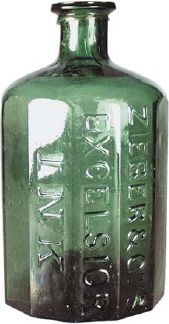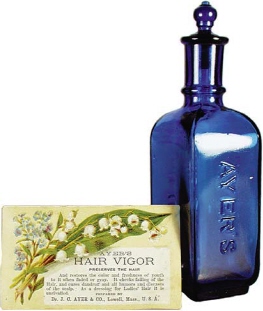
The Beginning Collector
Now that you have learned some basics about the history, origin, and process of producing a bottle, it’s time to provide information about how to approach the hobby of bottle collecting, as well as suggestions on books and reference guides, startup costs, old vs. new bottles, and information on bottle clubs and dealers.
So what approach should you take towards getting started, and what might infl uence that approach? The first thing to understand about antique bottle collecting is that there aren’t set rules. Everyone’s fi-nances, spare time, storage space, and preferences are different, so you will need to tailor your collecting to your own individual circumstances. As a collector, you will need to think about whether to specialize in a specifi c type of bottle or to be a general or “maverick” collector who acquires everything that becomes available.
Most bottle collectors that I have known over the years, including me, took the maverick approach as new collectors. We grabbed everything in sight, ending up with bottles of every type, shape, and color. Now, after 31 years of collecting, my recommendation to newcomers is to just do a small amount of maverick collecting and focus on a specific or specialized bottle or group of bottles. Taking the more general approach in the early years has given me more breadth of knowledge about bottles and glass, but specializing has the following distinct advantages over the maverick approach:

• It helps focus a collection, which will provide more time for organization, study, and research.
• It allows a collector to become an authority on bottles in a specifi c field.
• Trading becomes easier with other specialists who may have duplicate or unwanted bottles.
• By becoming more of an authority within a specialty, the collector can negotiate a better deal by spotting bottles that are underpriced.
I need to mention, however, that specialized collectors may be tempted by bottles that don’t quite fit into their collections. So, they cheat a little and give into that maverick urge. This occasional cheating sometimes results in a smaller side collection, or in some cases, turns the collector away from a specialty and back to being a maverick. But, that’s OK. Remember, there are no set rules, with the exception of having a lot of fun.
Now, what does it cost to start a collection and how can you determine the value of a bottle? Aside from digging excursions, which involves travel and daily expenses, collectors can start a collection by spending just a few dollars or maybe just a few cents per bottle. Digging, which is discussed in detail in the chapter “Digging for Bottles” is in my opinion, the ultimate way of adding to your collection and is how I started my addiction to the hobby.
Knowing what and where the best deals are obviously takes time and experience. But, the beginner can do well with just a few pointers. Let’s start with buying bottles, instead of digging for bottles, since this is a quicker approach with more sources available for the new bottle collector.
Over the years, I’ve developed a “quick look” method of buying bottles by grouping candidates into one of three categories:
 LOW-END OR COMMON BOTTLES
LOW-END OR COMMON BOTTLES
Bottles in this category show noticeable wear, and labels are usually missing or not very visible. In most cases, the label is completely gone and there is no embossing or identifiying markings. The bottle is dirty (although it can usually be cleaned), and has some scrapes, but is free of chips. These bottles are usually clear.
 AVERAGE GRADE / COMMON BOTTLES
AVERAGE GRADE / COMMON BOTTLES
Bottles of this type show some wear, and a label may be visible but usually is faded. They are generally clear in color or aqua and free of scrapes or chips. Some may have minimal embossing, but not likely.
 HIGH-END AND UNIQUE BOTTLES
HIGH-END AND UNIQUE BOTTLES
These bottles can be empty, partially full, or completely full, with the original stopper and label or embossing. They can be clear but usually are green, teal blue, yellow, or yellow green. The bottle will have no chips, scrapes, and very little wear. If it has been stored in a box, the bottle is most likely in good or excellent condition. Also, the box must be in very good condition.
Price ranges will be discussed only briefly here since pricing and values are covered in more detail in the “Determining Bottle Values” chapter. Usually the low-end category can be found for $1 to $5, the average grade will range from $5 to $20, and the high-end will range from $20 to $100. Anything above $100 should be examined closely by someone who has been collecting for a while and is knowledgeable.
I try not to spend more than $2 per bottle for low-end or $5 to $7 for average grade. It’s easier to stick to this guideline when you’ve done your homework, but sometimes you just get lucky. As an example, during a number of bottle and antique shows, I have found tables where the seller had “grab bags” full of bottles for $2 a bag. I never pass up this opportunity due to the low price and the lure of hidden treasure. After one show, when I examined my purchase, I discovered nine bottles, some purple, all pre-1900, in great shape, with embossing for a total cost of 22 cents per bottle. Now what could be better than that? Well, what was better was that I found a Tonopah, Nevada, medicine bottle valued at $100.
In the high-end category, deals are usually made after some good old horse trading and bartering. But, hey, that’s part of the fun. Always let the seller know that you are a new collector with a limited budget. It really helps. I have never run across a bottle seller who wouldn’t work with a new collector to try to give the best deal for a limited budget.
A collector should also be aware of the characteristics of old bottles versus new bottles and what makes a bottle antique. New collectors often assume that any old bottle is an antique, and if a bottle isn’t old it isn’t collectible. In the antique world, an antique is defi ned as an article more than 100 years old. But quite a number of bottles listed in this book are less than 100 years old yet are just as valuable—perhaps more so—than those that are officially antiques. As discussed earlier, the history, origin, background, use, and rarity of the bottle can be more important to a bottle collector than its age.
The number and variety of old and antique bottles is greater than the new collectible items in today’s market. On the other hand, the Jim Beams, Ezra Brooks, Avons, recent Coke bottles, figurals, and miniature soda and liquor bottles manufactured more recently are very desirable and collectible and are in fact made for that purpose. If you decide you want to collect new bottles, the best time to buy is when the first issue comes out on the market. When the first issues are gone, the collector market is the only available source, which limits availability and will drive the price up considerably.
An example of a company that has produced a great deal of collector items is the Coca-Cola Company. When Coca-Cola reissued the 8-ounce junior size Coke bottle in the Los Angeles area to garner attention in a marketplace full of cans, the word spread fast among collectors. The 8-ounce bottle had the same contour as the 6-1/2 ounce bottle that was a Coke standard from the 1920s into the 1950s and has also been issued as a special Christmas issue every year since 1992. The 6-1/2 ounce bottle is available in a few parts of the United States, most noteably in Atlanta, Georgia, where Coca-Cola is headquartered. When these 8-ounce bottles were issued, the “heavy duty collectors” paid in advance and picked up entire case lots from the bottling operations before they hit the retail market. The most recent example occurred in December 2007, when Coca-Cola issued a replica of the 1899 Coca-Cola bottles in a six-pack. They sold as a novelty for $3.99 and disappeared as soon as they hit the shelves. Some of the dealers are now selling these six-packs for $20-$25 each.
For the beginner collector, and even the old-timer, books, references guides, magazines, and other similar literature are readily available at libraries and bookstores. The bibliography at the back of this book lists various types of literature to get you started. Also, joining a bottle club can be of great value, as this will provide numerous new sources of information, as well as an occasional digging expedition. Various bottle clubs are also listed in a separate chapter of this book.
I want to finish with a final note on reproductions and repaired bottles. Always check a bottle, jar, or piece of pottery carefully to make sure that there have been no repairs or special treatments. It’s best to hold the item up to the light or take it outside with the dealer to look for cracks, nicks, or dings. Be sure to check for scratches that may have occurred during cleaning. There are also a number of bottles and jars that have reproduction closures. The proper closure can make a difference in the value of the bottle, so it’s important to make sure the closure fits securely, and that the metal lid is stamped with the correct patent dates or lettering. If you need help, don’t hesitate to ask an experienced collector. In order to better understand the hobby, new bottle collectors should learn about identification, grading, labeling, and glass imperfections and peculiarities, which are explained in more detail in the following chapters.
Now, get out to the antique and bottle shows, flea markets, swap meets, garage sales, and antique shops. Pick up those bottles, handle that glass, ask plenty of questions, and soon you will be surprised by how much you have learned, not to mention how much fun you’ll have.
